From exploring the Forbidden City to walking along the famous Great Wall of China, here is our list of the absolute best things to do in Beijing.
Welcome to one of the most awe-inspiring, mind-blowing and just plain crazy cities on the face of the earth.
Beijing has everything: history, culture, stunning scenery, food and a healthy dose of culture shock.
I first visited Beijing back in 2008 just before the Beijing Olympics and I loved it so much that I returned in 2011 and lived there for over 7 years.
It became my home in a way I never imagined and to this day it is still my favourite city in the world.
There are so many awesome things to do, that you will be spoilt for choice.
Beijing is a city that has changed constantly throughout its history.
Walls, palaces and temples have been knocked down and replaced as the city grew from a small settlement to one of the largest cities on earth.
Beijing’s history is intertwined with the story of China.
The city was a great power until the industrial revolution when the colonial powers came knocking on China’s door demanding it open for trade.
At this point, Beijing was the seat of power, and the Forbidden City was the centre of the known universe and the heart of one of the largest empires on earth.
Over the course of the 1800’s China and Beijing’s fortunes reversed.
READ MORE: Check out our comprehensive China travel guide if you’re planning a visit!
Wars, unequal treaties and poor governance lead to the collapse of the Qing Dynasty and Imperial China.
What followed was the Civil War, the Japanese invasion and more Civil War.
Beijing was at the centre of this change and strife. So it was fitting that in 1949 Chairman Mao’s People Liberation Army marched into Beijing and Mao himself stood atop the gate of heavenly peace saying the Chinese people had stood up.
The Peoples Republic of China was formed and power was back in Beijing.
As China continues it’s rapid ascension to the upper echelons of the geopolitical tower this only enhances the importance, power and prestige of Beijing.
Table of Contents
- The Best Things to Do in Beijing
- 1) See The Flag-Lowering Ceremony At Tiananmen Square
- 2) Visit Chairman Mao’s Mausoleum
- 3) Check Out the Forbidden City
- 4) Take a Relaxing Wander Around Jingshan Park
- 5) Get Lost Wandering Around the National Museum of China
- 6) Visit the Lamma Temple
- 7) Escape the Crowds at the Confucius Temple and Imperial College
- 8) Take a Wander Around Xiangshan
- 9) Be Amazed by the Summer Palace
- 10) Wander Around the Ruins of the Old Summer Palace
- 11) Visit Tianyi’s Mausoleum
- 12) Be Amazed by the Stunning Frescos at Fahai Si
- 13) See Where Many Historians Say World War 2 Started
- 14) Take a Wander Through the City’s Hutongs
- 15) Check Out Some Awesome Art in 798
- 16) Explore the Temple of Heaven
- 17) Get Stuck into Some Square Dancing
- 18) Eat Real Peking Duck (北京烤鸭)
- 19) Find All Manner of Awesome Stuff at the Panjiayuan Antiques Market
- 20) Get a Foot Massage
- 21) Take a Wander Down the Foreign Legation Quarter
- 22) Get Stuck into Bargaining Around Xidan
- 23) Throw Down Some Baijiu
- 24) Explore One of Beijing’s Many Hidden Temples
- 25) Take a Trip to Stunning Cuandixia
- 26) Visit the Great Wall of China
- Beijing Travel Guide
The Best Things to Do in Beijing
There is no other city in the world like Beijing.
From some of the most impressive structures ever built in the ancient world to the hutongs (胡同 narrow alleyways) that are the city’s heart and soul, this is a city of contradictions, chaos and a healthy dollop of China.
Beijing is most famous for the Great Wall of China, the Forbidden City, Tiananmen Square and the Hutongs.
However, there are plenty of other cool things to do here, so enjoy our list of awesome things to do in Beijing.
1) See The Flag-Lowering Ceremony At Tiananmen Square
Not sure what to do in Beijing? Then start with a visit to Tiananmen square.
For many, this is what first springs to mind when anyone thinks of China’s capital.
This gargantuan public square (the seventh-largest in the world) is flanked by the National Museum of China on one side and the Great Hall of the People (the building that hosts various meetings and events of the Communist Party) on the other.
Every day the Chinese flag is risen at sunrise and lowered at sunset.
Either of these times is atmospheric. However, the sunset is particularly beautiful.
As the sky darkens the Forbidden City and Tiananmen Square are lit up.
This is definitely one of the best things to do in Beijing.
- Nearest Subway: Tiananmen East on Line 1
- Opening Hours: Flag raising to flag lowering. Therefore if you watch the flag-lowering ceremony, you will watch it from the roads next to the square itself.
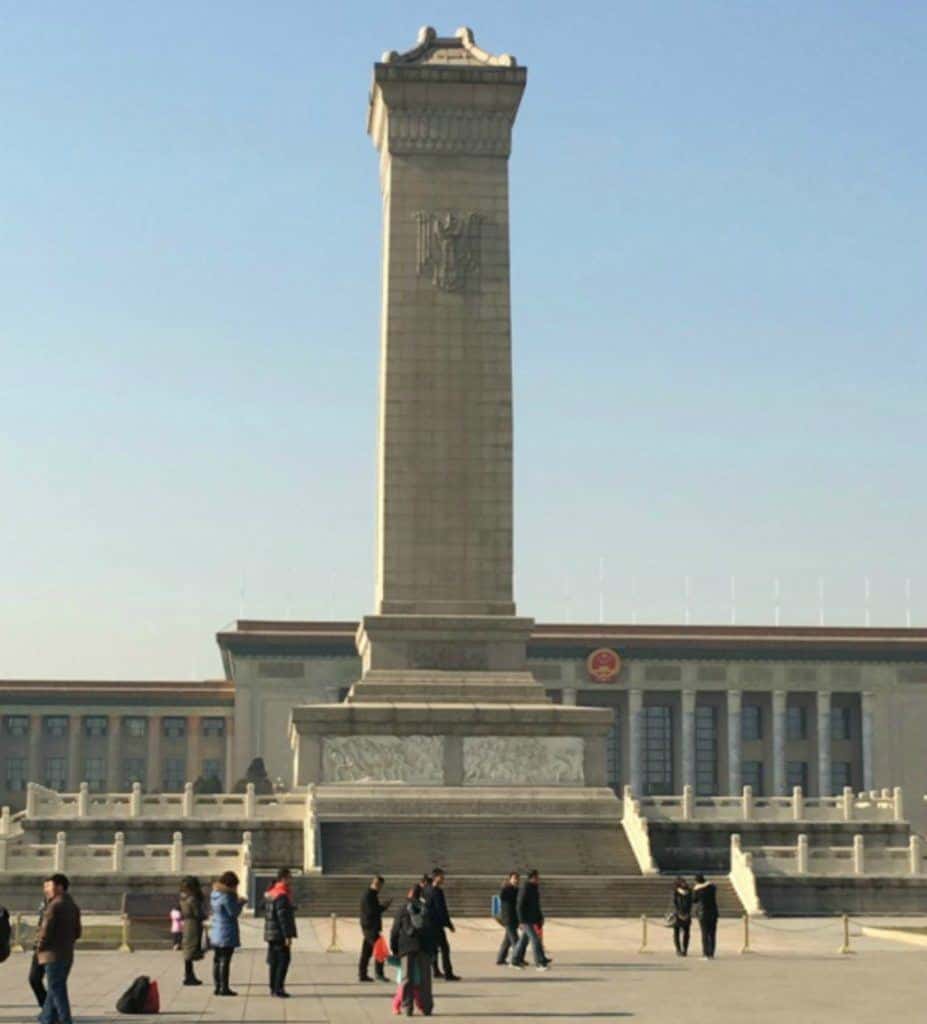
2) Visit Chairman Mao’s Mausoleum
Located in the centre of Tiananmen Square is Chairman Mao’s Mausoleum.
To get onto Tiananmen Square itself you will need to bring your passport and go through a bag check.
The lines to get in and pay your respects can be very long, especially during national holidays. During this time it can seem like this is the most popular Beijing attraction.
Going earlier in the day can usually avoid this.
You cannot take camera’s in, and they are very strict about it. However, this rule may change.
Again, to get in you will need to show your passport and have your bag checked. Shorts, flip flops and vests are not permitted.
You can purchase flowers to show your respects if you would like.
As you pass through be silent and do not stop walking. When you exit the mausoleum you will be at the south end of Tiananmen Square, so you a stone’s throw from exploring the Qianmen area.
Be prepared to be offered all kinds of Mao memorabilia.
- Nearest Subway: Qianmen or Tiananmen East
- Opening Hours: 8:00 am – 12:00 pm from Tuesday to Sunday
READ MORE: If you’re visiting China, make sure you check out Mount Huashan, the world’s most dangerous hike!
3) Check Out the Forbidden City
If you’re wondering what to do in Beijing, then you can’t miss this…
Welcome to one of Beijing’s, and indeed China’s, most stunning historical destinations.
From 1368 – 1911 this was the home of 24 emperors and the centre of the Chinese world.
Make no mistake the Forbidden City is huge. Inside is a mixture of palaces, courtyards, temples, gardens and museums.
The sheer size and majesty are overwhelming and it’s hard to believe this it’s over 600 years old. This is definitely a must-do in Beijing.
You can only book tickets online so as the number of visitors can be controlled.
You will need to bring your passport with you as this is the ID you use when booking your tickets.
Do be aware that the Forbidden City is closed on Mondays and can be particularly busy during national holidays.
Even with the crowds, this is definitely a Beijing must-see.
- Nearest Subway: Tiananmen East
- Opening Hours: 8:30 am – 5:00 pm from April to October, and 8:30 am – 4:30 pm from November to March. Closed on Mondays.
- Cost: 60 Yuan
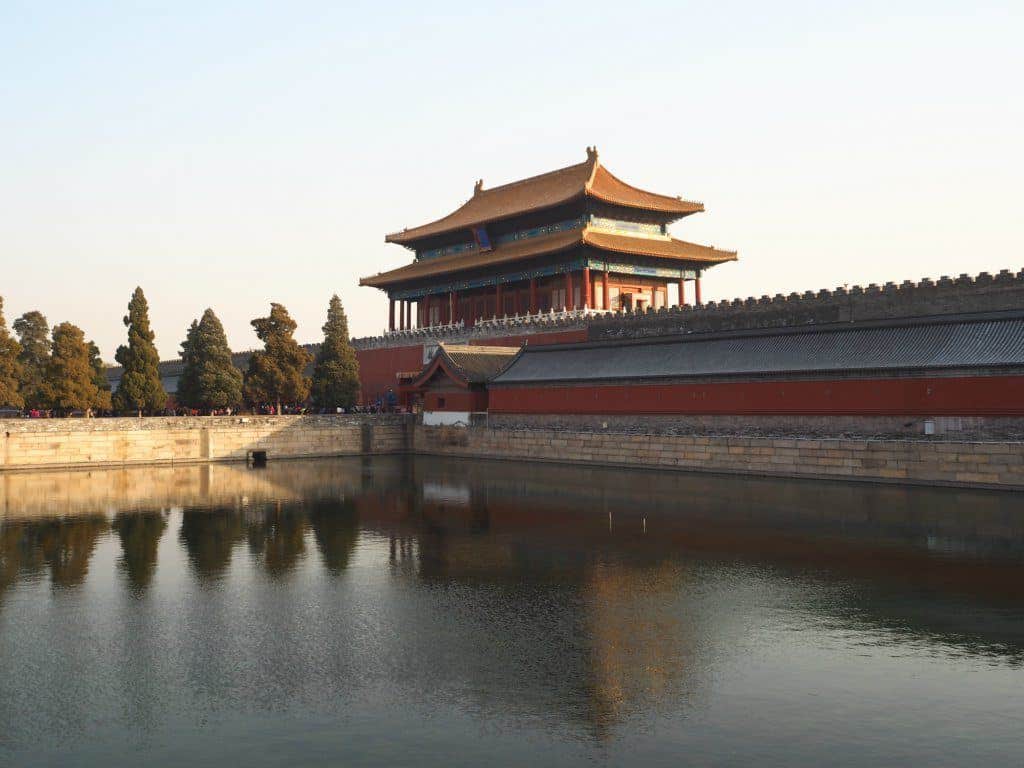
4) Take a Relaxing Wander Around Jingshan Park
At the northern end of the Forbidden City (the exit), you will find Jingshan Park.
If you’re looking for some excellent views of the Forbidden City then this is the place to come.
Sunset is particularly nice and is certainly one of the top things to do in Beijing.
However, for convenience, you could just visit this park straight after visiting the Forbidden City. It would certainly be a nice change of pace from the crowds and chaos nestled within the walls of the Forbidden City.
- Nearest Subway: It’s probably Beihaibei on line 6, but it’s a fair trek away. You will be better off getting a bus if you are coming here directly and not coming from the Forbidden City. For anything bus-related, you will need to download Baidu Ditu, the Google Maps of China.
- Opening Hours: April to October: 6:00 am – 9:00 pm, ticket sale ends at 8:30 pm. November to March: 6:30 am – 8:00 pm, ticket sale ends at 7:30 pm
- Cost: 2 Yuan
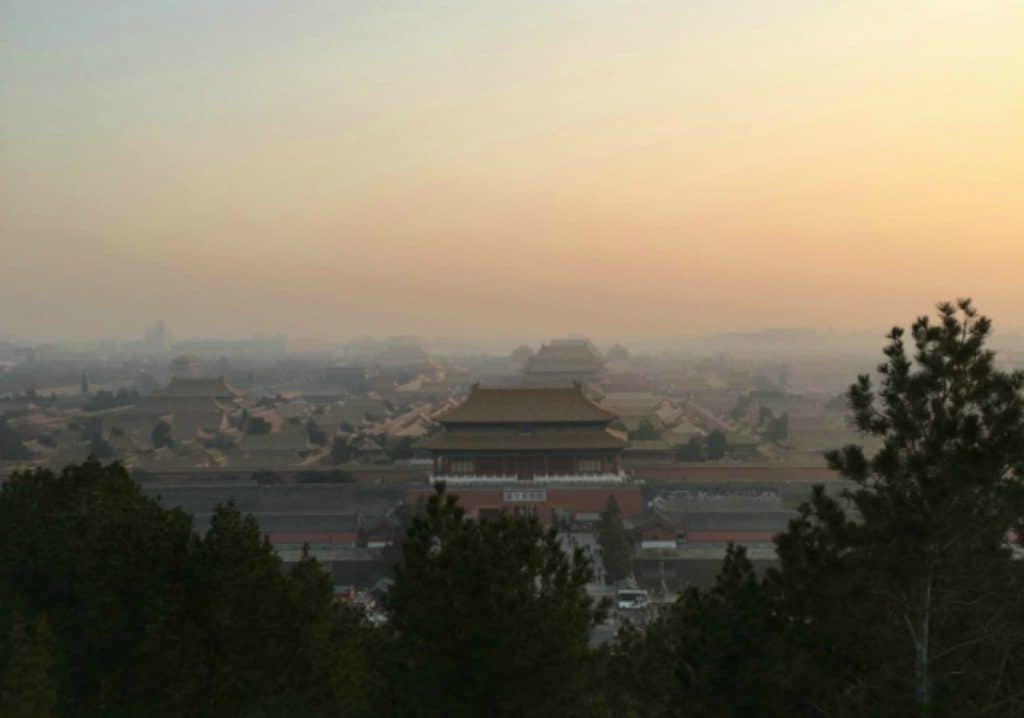
5) Get Lost Wandering Around the National Museum of China
Located on the eastern edge of Tiananmen Square is the phenomenal Museum of China.
Bring your passport and expect long queues to get in.
There is a lot to see here and the English captions are generally very good throughout.
- Nearest Subway: Tiananmen East on line 1 or Qianmen on line 2
- Opening Hours: 9:00 am – 5:00 pm. Tickets are issued until 3:30 pm and the last entry is 4:00 pm.
- Cost: Free
6) Visit the Lamma Temple
This spectacular Tibetan Buddhist Temple is a central pillar of the Buddhist world in Beijing.
It certainly one of the most spectacular Tibetan temples outside of China’s far-flung Himalayan province.
There are a couple of interesting museums inside that are well worth checking out.
If you’re here during a major holiday there is a good chance that the temple will be chock full of worshippers coming and lighting incense.
With 3 stunning archways, 5 main halls that grow in size and a giant prayer wheel it’s easy to see why this is such a focal point for Buddhism in Beijing.
- Nearest Subway: Yonghegong (Lamma Temple) on line 2 and 5.
- Opening Hours: 9:00 am – 4:30 pm from April to October and 9:00 am to 4:00 pm from November to March.
- Cost: 25 Yuan
7) Escape the Crowds at the Confucius Temple and Imperial College
Nestled in the hutongs to the west of the Lamma Temple you will find the Confucius Temple.
Head down Guozijian from the Lamma Temple and you will soon see it on your right-hand side.
This is the site of the second-largest Confucian Temple in China. (The largest temple is in the great philosopher’s hometown of Qufu in Shandong.)
It has an almost ethereal atmosphere as if time has stood still.
Upon stepping over the threshold the sights, sounds and smells of a city of 20 million or so people disappear.
As well as being a homage to Confucius himself, this was also the site of the Imperial Examinations.
Passing these guaranteed wealth, status and life in the government during the time of Imperial China.
These tests focused on the candidates’ knowledge of the classics and literary style, not technical expertise, which as you can imagine lead to more than few issues before the Imperial Examination system was abolished in 1905.
Students would be tested in 1.5-metre cells over the course of 3 days.
Within the temple grounds, you will find the 13 Confucian classics written on 190 stelae, all 630,000 characters worth.
- Nearest Subway: Yonghegong (Lamma Temple) line 2 and line 5.
- Opening Hours: 8:30 am – 6:00 pm (sales end at 5:30 pm) from May to October. From November to April its 8:30 am – 5:00 pm (sales end at 4:30 pm).
- Cost: 30 Yuan.
READ MORE: Don’t miss out on our guide on how to spend 3 days in Chengdu!
8) Take a Wander Around Xiangshan
Literally translated as ‘fragrant hills’ in English, this spectacular park out in Beijing’s north-west is home to some lovely views, great walking trails and a memorial hall dedicated to Sun Yat-Sen, the man who founded the Republic of China after the collapse of the Qing Dynasty.
With its own stop on the Beijing subway system, Xiangshan is easier to visit than ever.
Head up to the parks highest point, Xianglu Peak for some lovely views out over western hills.
From here you can hike further into the hills to escape the crowds if you wish.
This spot is very popular in autumn as Beijingers flock to view the hills become splashed with red and orange.
Between the entrance and Xianglu Peak, there are a variety of trails, pathways pavilions and temples that snake their way up to the parks highest point.
Make sure you check out Zhao Miao (Zhao temple) as well.
Close to the north gate of Xiangshan is the Azure Clouds Temple (Biyun Temple) which costs 10 Yuan and is open from 8:00 am to 5:00 pm.
Here you can visit the memorial hall of Dr Sun Yat Sen, one of the most important and revered figures in Chinese history.
- Nearest subway station: Xiangshan on the western suburban line. From here it’s just under 1km to the park entrance.
- Opening hours: 6:00 am – 6:30 pm – April to June and September to mid-November. 6:00 am – 7:00 pm July to August. 6:00 am – 6:00 pm mid-November to March.
- Cost: Park and Biyun Temple – 15 Yuan from April to mid-November and 14 Yuan outside of that.
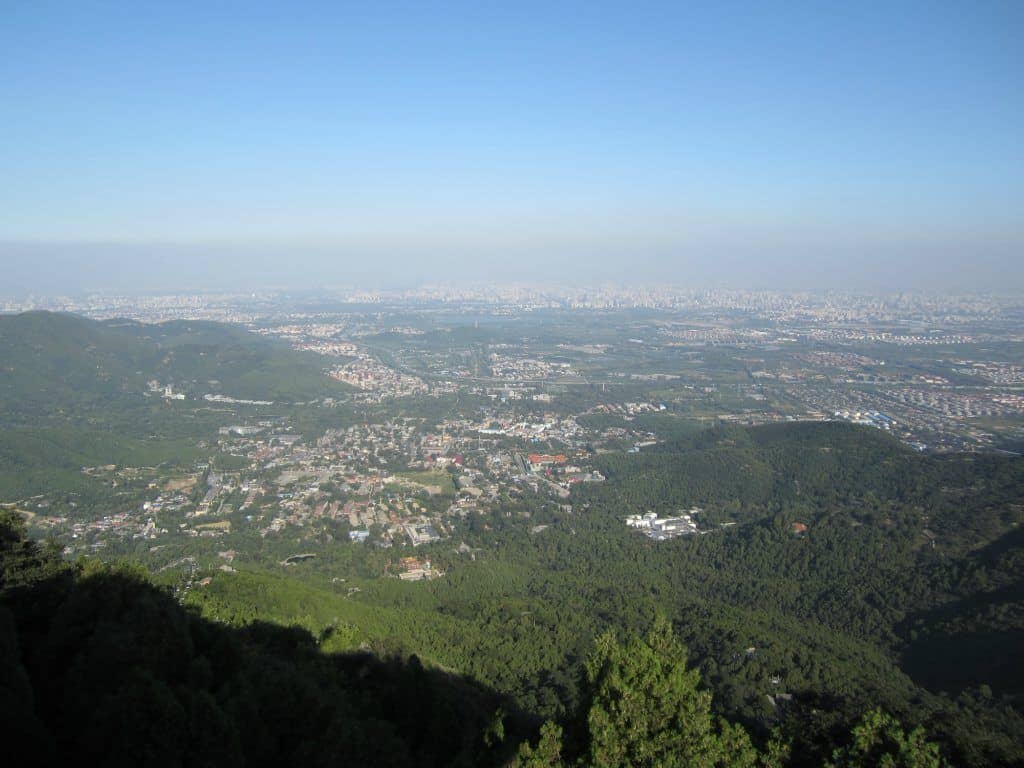
9) Be Amazed by the Summer Palace
Way out in Western Beijing, close(ish) to Xiangshan, is the stunning Summer Palace.
This was built by the Qianlong Emperor in the 18th century with the help of 100,000 labourers.
After the Summer Palace was badly damaged by British and French forces, the Empress Dowager Cixi began a major refit in 1888.
However, the money that she used for this refit was originally destined for the Chinese navy.
After China’s crushing defeat in the First Sino-Japanese War 1894-95, this act of corruption certainly came to the fore.
After the collapse of the Qing Dynasty, the Summer Palace fell into a state of disrepair and an overhaul began upon the formation of the PRC in 1949.
Longevity Hill offers some stunning views over Kunming Lake and then snakes down through a number of Pagodas and pavilions giving you a true insight into the opulence of Imperial China.
After exploring the Longevity Hill area head out towards Kunming lake.
Be under no illusions, Kunming Lake is pretty large so it’s certainly not a short walk.
However there a number of gorgeous bridges that are well worth checking out. The pick of these being the 17-Arch Bridge.
On a clear day, this really is one of the best things to do in Beijing, with views from the top of Longevity Hill stretching right the back into Central Beijing.
- Nearest subway: Xiyuan on line 4
- Opening hours: April to October – 6:30 am to 6:00 pm and November to March – 7:00 am to 5:00 pm.
- Cost: April to October – 60 Yuan and November to March 50 Yuan.
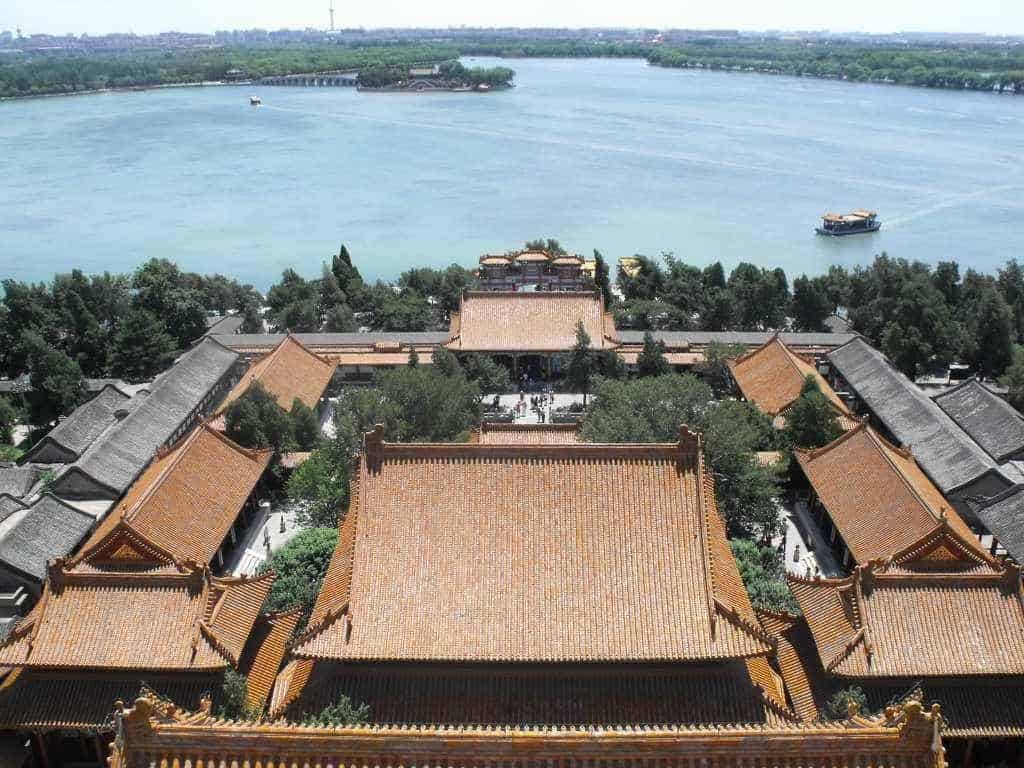
10) Wander Around the Ruins of the Old Summer Palace
The Old Summer Palace is actually the former site of the Imperial Gardens.
In 1860, during the Second Opium War, the site was burnt and looted by British and French forces.
Numerous artworks were stolen and can now be found in 47 museums around the world.
At over 800 acres in size, it took 4,000 men 3 days to burn it to the ground.
The Great Fountain Ruins are some of the best-preserved and offer the opportunity to reimagine the gardens at the grandest and most spectacular.
The gardens are home to numerous pavilions, temples and lakes.
There are also some excellent exhibits focusing on the history of the Old Summer Palace.
- Nearest subway station: Yuanmingyuan on line 4.
- Opening hours: May to August – 7:00 am to 7:00 pm. April, September and October – 7:00 am to 6:00 pm. January, February, March, November and December – 7:00 am to 5:30 pm.
- Cost: 10 Yuan, with additional costs for other exhibitions and sites.
11) Visit Tianyi’s Mausoleum
Way out in Beijing’s Babaoshan district is the home of two of cities most off the beaten track destinations.
Tianyi was a eunuch that was castrated at the age of 9 and went on to serve in the imperial court for 63 years.
Upon his death, the emperor demanded 3 days of mourning and ordered the creation of the mausoleum.
As well as being a monument to the life of Tianyi, there are also some excellent exhibits discussing the importance of eunuchs in Imperial China. A rather gruesome, yet fascinating area of Chinese history.
This is definitely one of the most interesting places to see in Beijing and one that is very much off the beaten track.
- Nearest subway station: Take line 1 all the way to Pingguoyuan, and then take bus 116, 396, 336 or 972 to Shougangxiaoqu (首钢小区).
- Opening times: 9:00 am – 4:00 pm.
- Cost: 8 Yuan.
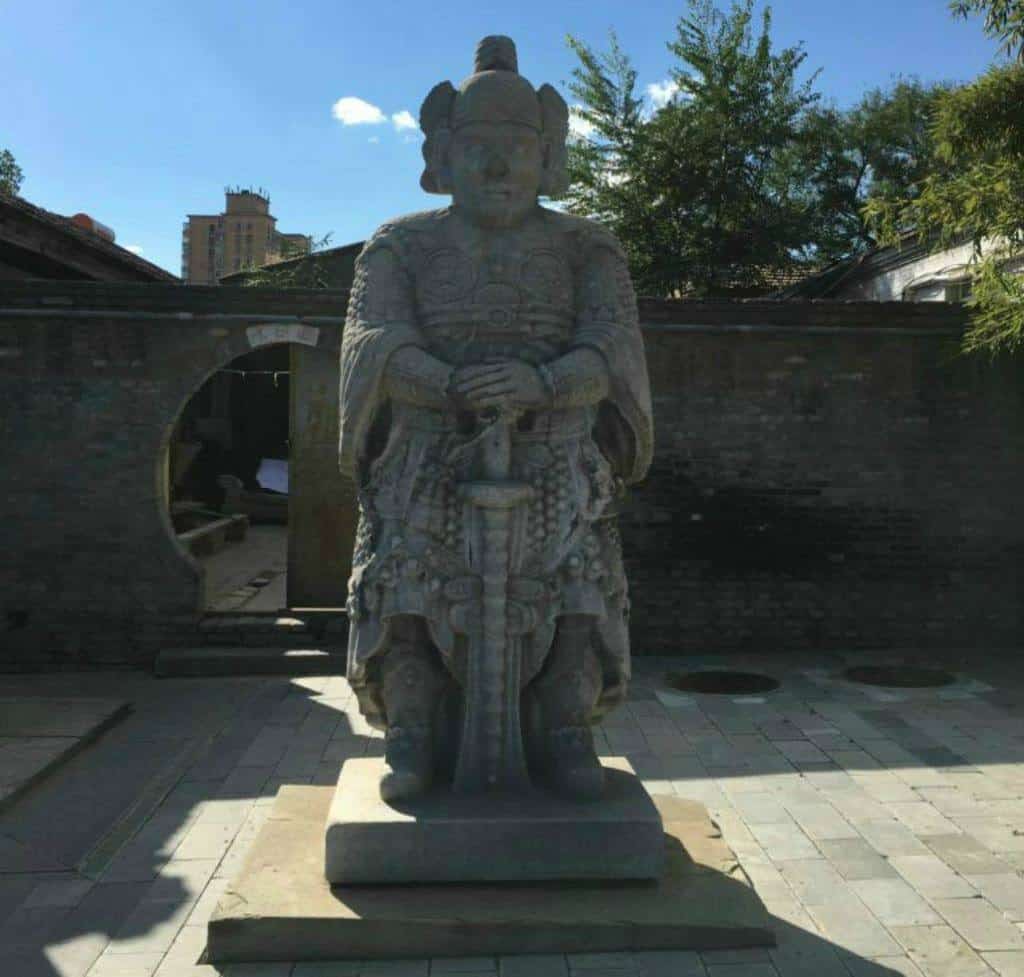
12) Be Amazed by the Stunning Frescos at Fahai Si
A short walk from Tianyi’s Mausoleum is the stunning Fahai Si (Fahai Temple).
It what’s inside the temple that is most notable; its stunning Buddhist frescos.
Due to the sensitivity of the paintings, the doors are kept closed and you need to go with a tour that can be arranged when you have arrived.
Safe to say they are stunning, although the tour is in Mandarin. You can just enter to look around the temple grounds itself as well.
- Nearest subway station: Same as for Tanya’s mausoleum.
- Opening times: 9:00 am – 4:00 pm, closed on Mondays.
- Cost: 20 Yuan to enter the temple grounds, 100 Yuan to combine this with a tour of the frescos.
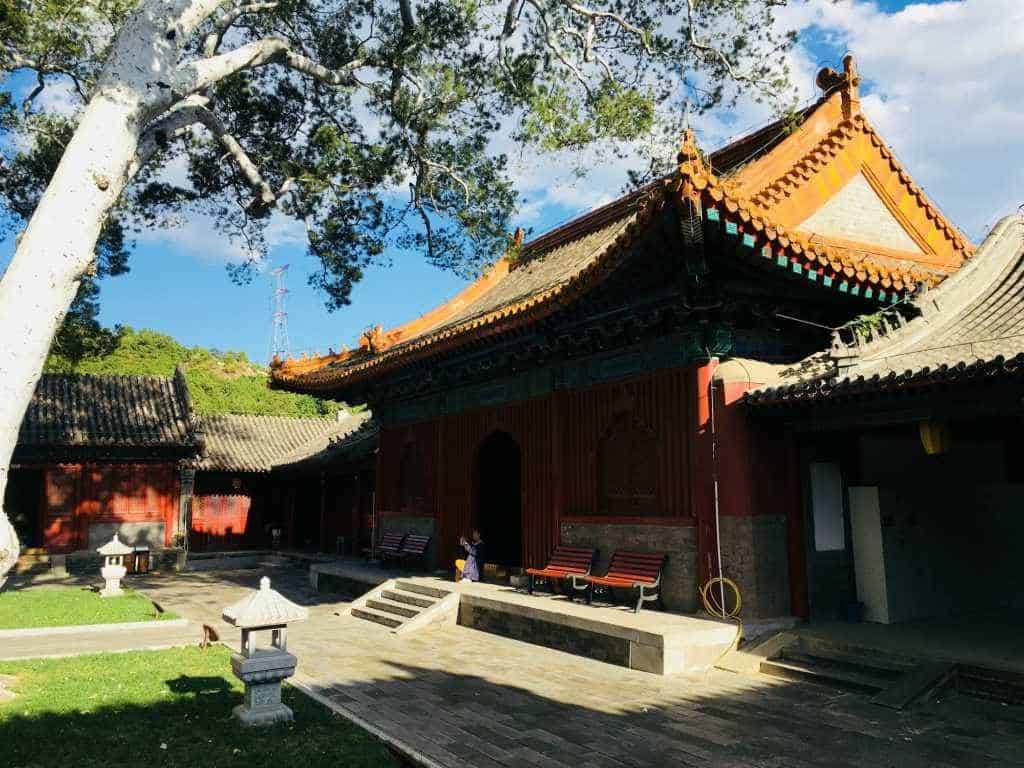
13) See Where Many Historians Say World War 2 Started
Another trip out to Beijing’s far western suburbs will take you to the Marco Polo Bridge and the small fortified town of Wanping.
It was here in 1937 that the Imperial Japanese Army demanded to enter Wanping to search for a missing soldier.
When this was refused they opened fire. Crucially, things did not calm down after this incident as had been the case in previous skirmishes across Manchuria.
It leads to a full-blown invasion of China by the Imperial Japanese Army.
Hence why it is this point that is considered the beginning of the second Sino-Japanese War and thus, by extension, World War Two.
The Chinese forces held Wanping and the Japanese forces surrounded them and crossed the famous Marco Polo Bridge.
This name comes from the fact it was included in Marco Polos famous travel diaries in which he believed the bridge to be one of the most beautiful in the world.
The bridge and Wanping are both riddled with bullet points, a stark reminder of one of the darkest periods in Chinese history.
- Nearest subway station: Head to Beijing West Station and then take bus 309 to Lugou Xinqiao.
- Opening hours: 7:00 am – 8:00 pm April to October, 7:00 am – 6:00 pm November to March.
- Cost: 20 Yuan
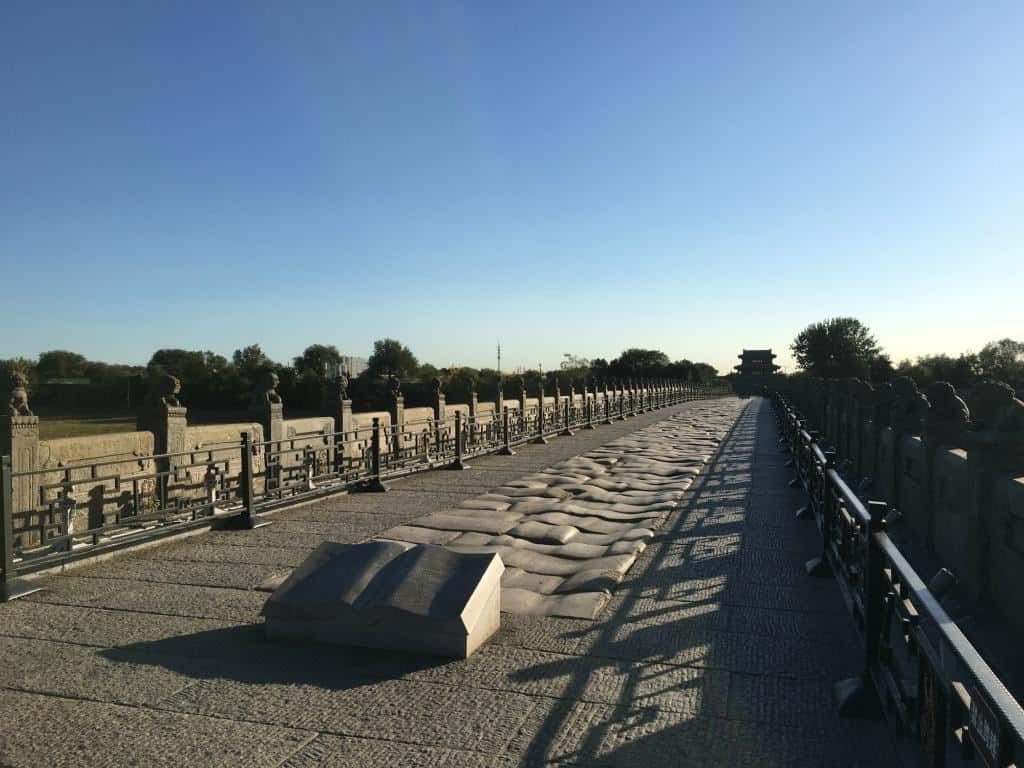
14) Take a Wander Through the City’s Hutongs
For many, this is where the heart of Beijing lies.
The winding alleyways of homes and businesses are what Beijing used to be made up of.
However, Beijing’s rampant growth over the last few decades has seen the number of hutongs decline dramatically.
In truth, these wonderful examples of old Beijing are not modern homes.
Insulation and sanitation are poor in many cases. Some of the really old hutong homes don’t have bathrooms and there will be a shared bathroom used by the neighbourhood.
Taking a wander through the hutong’s is one of the best things to do in Beijing.
This is especially true early in the morning or late in the afternoon when the life and soul of the community are out and about.
My favourite hutongs are the areas around the Drum Tower (head to Gulou Dajie and then head south-east), the area between Qianmen and Qiaowan subway stations and the area south-west of Caishikou subway station.
The joys of the hutong’s come from getting lost in the maze of alleyways and getting a taste of the old Beijing life.
Ride a rickshaw through Beijings Hutongs on this great tour on Get Your Guide!
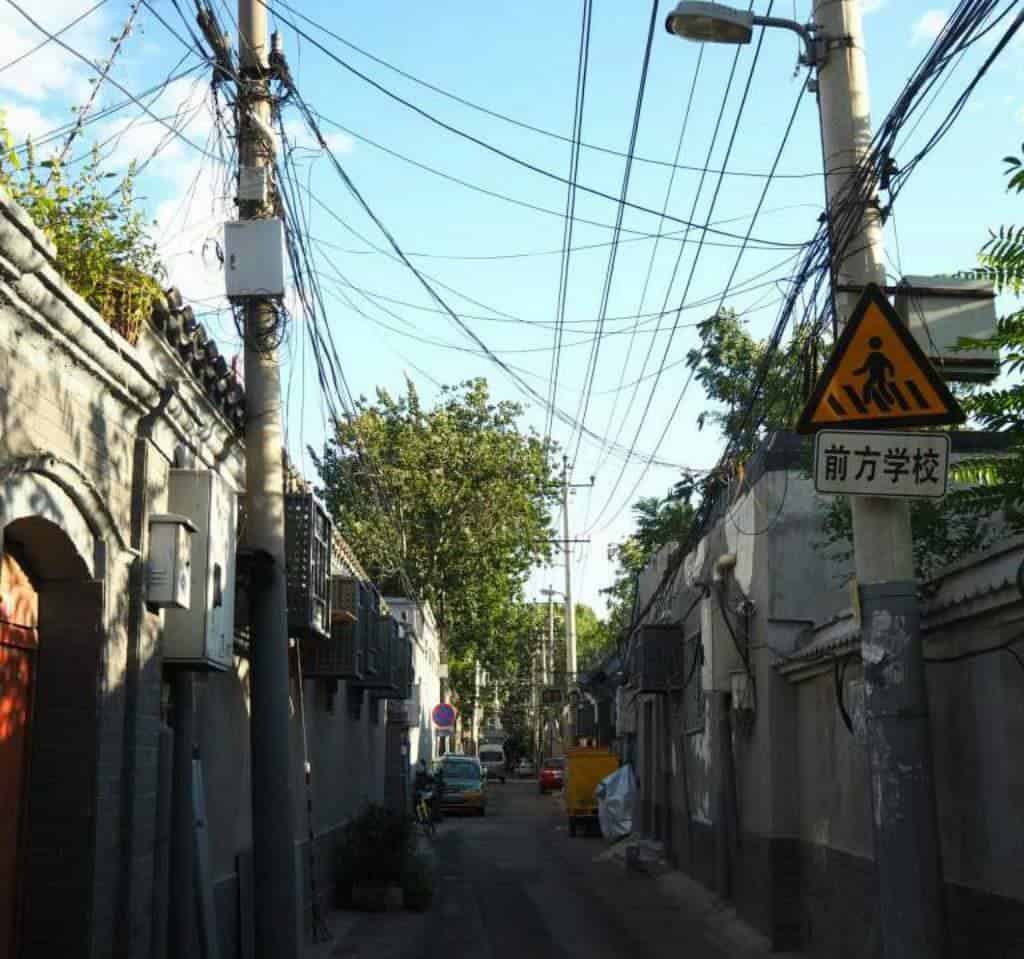
15) Check Out Some Awesome Art in 798
Up in the city’s northeast, you will find a sprawling area home to an incredible array of galleries and art exhibitions.
This area is home to some of Beijing’s hippest and funkiest hangouts.
Take a day to explore the wide variety of art on offer when you visit Beijing.
- Nearest subway station: Wangjing South on line 14
- Opening times: 10:00 am to 6:00 pm
- Cost: Free to enter most galleries, however, some will charge fees
16) Explore the Temple of Heaven
One of China’s most important religious sites, the Temple of Heaven is a Unesco World Heritage Site and a true demonstration of the power and majesty of Imperial China.
The site is huge. However, the highlight is the temple itself.
If you want to see a true slice of Beijing, get here very early in the morning, around 6 am then you will be treated to huge groups doing tai chi.
Later on in the day, you may be able to catch one of the marriage markets where parents try to fix their single children up with desirable suiters.
The latter of these is certainly one of the more unique Beijing sights.
Our tip – Book your ticket online and skip the line!
- Nearest subway station: Tian Tan on line 5
- Opening times: April to October – 6:00 am – 10:00 pm and November to March – 6:30 am – 10:00 pm.
- Cost: 35/30 Yuan.
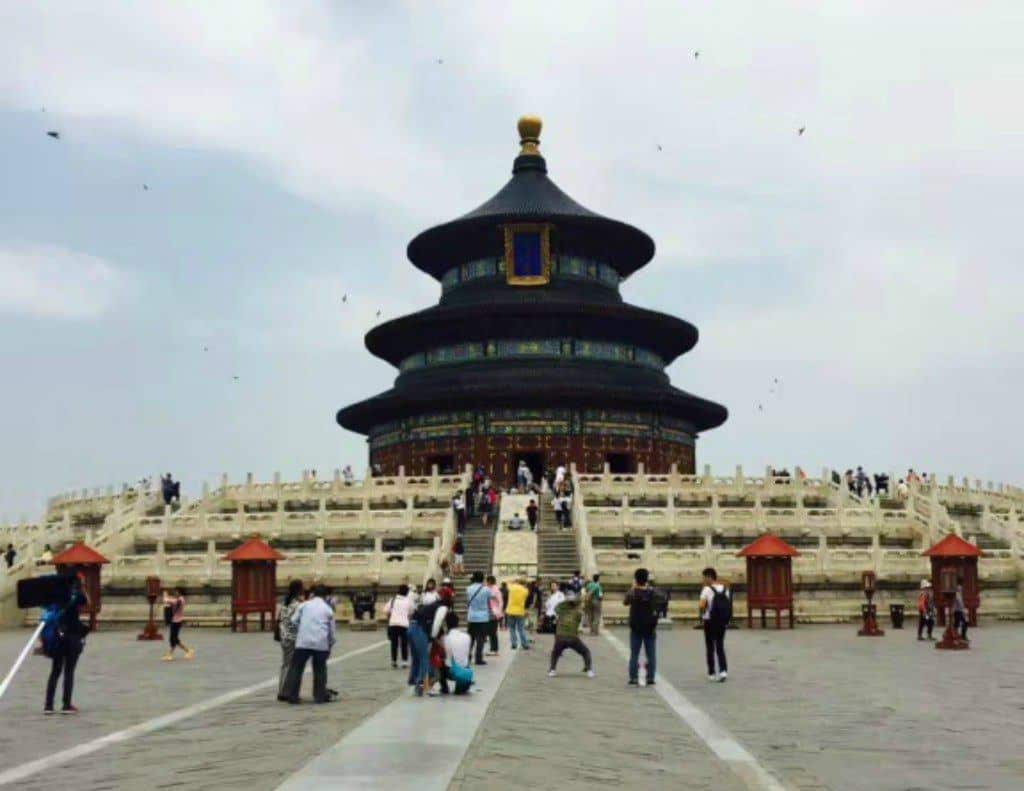
17) Get Stuck into Some Square Dancing
This rather modern Chinese activity happens in a number of public spaces in the evenings.
Activities range from outdoor karaoke to inline skating. However the most common and accessible is dancing.
Huge groups of Beijingers get together as the sun goes down to dance the night away.
You may have to pay to join some of these classes. However, they are great fun.
The best place to find these is in some of the cities residential areas. Check with your accommodation where the best place is to get involved.
Incidentally, the area around the Birds Nest Stadium, at the Olympic Park, is a particularly awesome place to see this in action.
Plus you get the sight of the Birds Nest Stadium lit up at night!
18) Eat Real Peking Duck (北京烤鸭)
For many, this is THE quintessential Beijing dish.
Head over to Sijiminfu (四季民富) close to Dongsishitiao subway station.
They do not take reservations so you will need to turn up, get a ticket and wait.
Fortunately, you can head off and explore the surrounding area while you wait and leave your phone number with the restaurant.
They will call you when your table is ready. However, if you can’t be back in time you will lose your spot.
Getting stuck into some Peking Duck and some of the other mouth-watering dishes here is definitely one of the top things to do in Beijing.
Eat Peking Duck while taking in a kung fu show with this tour!
19) Find All Manner of Awesome Stuff at the Panjiayuan Antiques Market
This fantastic market, located in the cities south-east, is home to all manner of antiques, artwork, books, knick-knacks and just about everything in between.
If you are looking to pick up some classic Mao-era posters and some walnuts (to roll around in your hands, not eat) then this is a great place to start.
Shopping here is absolutely one of the most fun things to do in Beijing, however, get ready to bargain hard.
- Nearest subway: Panjiayuan on line 10
- Opening hours: Roughly 9:00 am till 6:00 pm but they may go on a little later.
- Cost: Free
20) Get a Foot Massage
You will find these places all over Beijing, you just need to look for these characters – 足疗.
But be prepared for these to hurt. It’s not soft and relaxing, however, you will feel much better afterwards.
Although there certainly will be a language barrier, most places will understand the inevitable ‘ow.’ More often than not your pain will get plenty of laughs from the masseurs.
This definitely becomes one of the top Beijing activities, as it will set your feet right as rain after a day hiking on the Great Wall.
21) Take a Wander Down the Foreign Legation Quarter
Close to Tiananmen Square, you will find Dongjiaomin alley.
This street was home to the foreign legations during the Qing Dynasty at a time where China was at the mercy of the Western Powers.
It is definitely a historical point of interest in Beijing.
- Nearest subway: Chongwenmen line 2 and line 5 and take exit E and it’s immediately on your left.
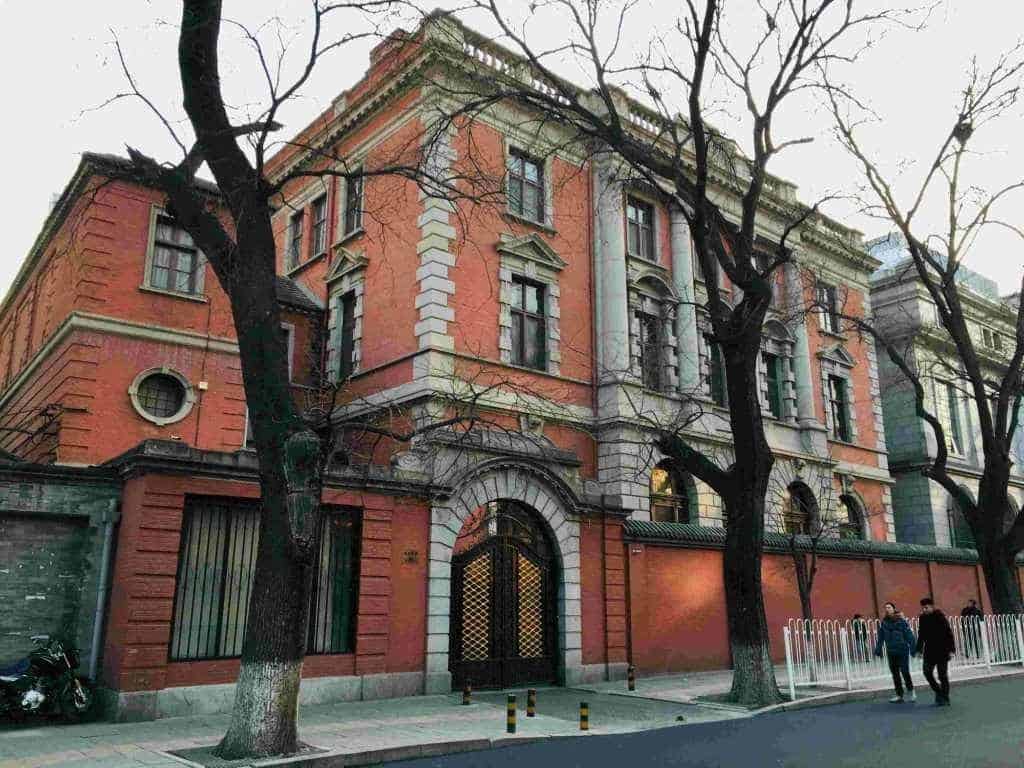
22) Get Stuck into Bargaining Around Xidan
If you’re looking for a place to find some bargains and get lost amongst the market stalls then Xidan is a great place to start.
Many tourists end up at the Silk Market (also known as Silk Street) near Yonganli.
However, you will likely get ripped off here and will end up sharing the entire place with tourists as the locals do not shop here.
Xidan is full of bargains, hardly any tourists and an opportunity to really test your bargaining skills.
- Nearest subway station: Xidan on line 1 and 4
23) Throw Down Some Baijiu
Chinese liquor consists predominantly of rice wine. The fieriest of which is called Baijiu.
More often than not this is 50% or higher and tastes like what I imagine rocket fuel tastes like.
However, do not be surprised if drinking it will attract the interests of some local Beijingers.
24) Explore One of Beijing’s Many Hidden Temples
Beijing is home to a number of incredible temples that receive hardly any visitors wandering around them is very enjoyable.
Amongst them, some highlights would be the Fayuan Temple, close to Caishikou subway station, the Tianning Temple, close to Daguanying subway station and the White Cloud Temple just north of it.
If you’re looking for quiet relaxing places to go in Beijing then this is a great start.
Usually, they are open from 8 am to 4 pm and cost between 10 and 20 Yuan to enter.
The chances are you that you will share your visit with barely even a handful of people.
Enjoy the opportunity to get a bit of zen in this city of 20 million.
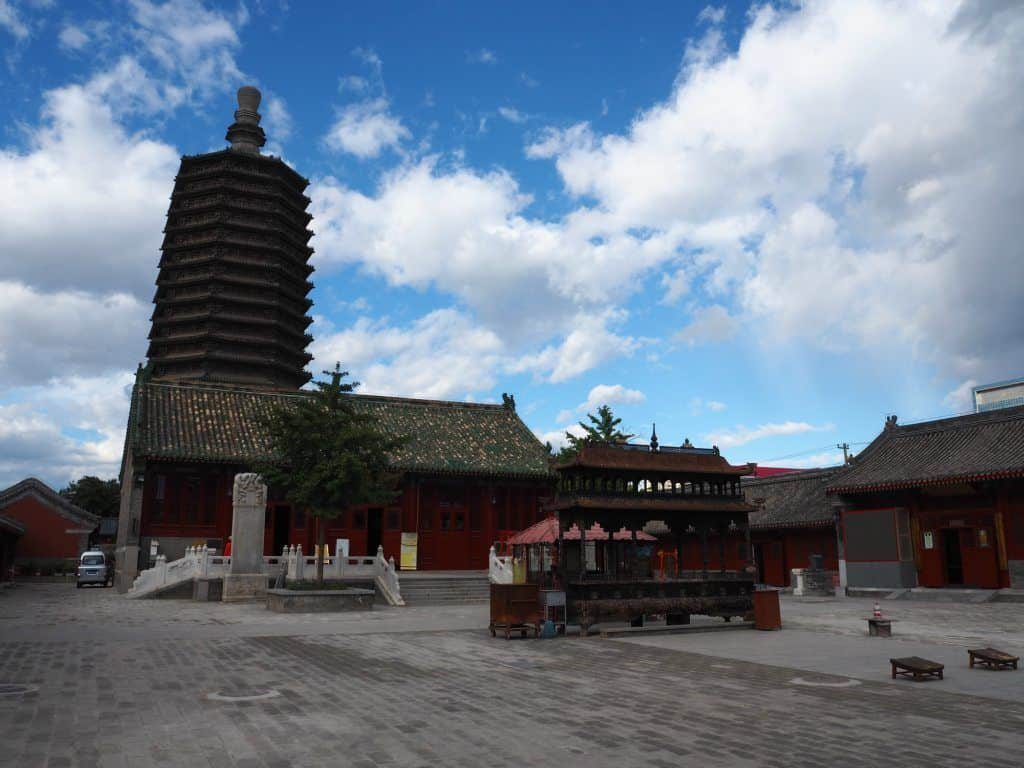
25) Take a Trip to Stunning Cuandixia
This gorgeous town way out in West Beijing is nestled in a valley offering spectacular views and some decent hiking trails.
Although it’s a reasonable trek from the city centre it is one of the best things to do in Beijing giving you the chance to experience something more in line with many peoples perceptions of China.
The narrow alleyways that make it a fascinating place to explore and the trails into hills offer some stunning views.
The long trek out here is absolutely worth it.
- Getting there: Take the subway Pingguoyuan on line 1 and then take a bus or a minibus from there. Drivers will find you, one way should be between 30 and 50 Yuan.
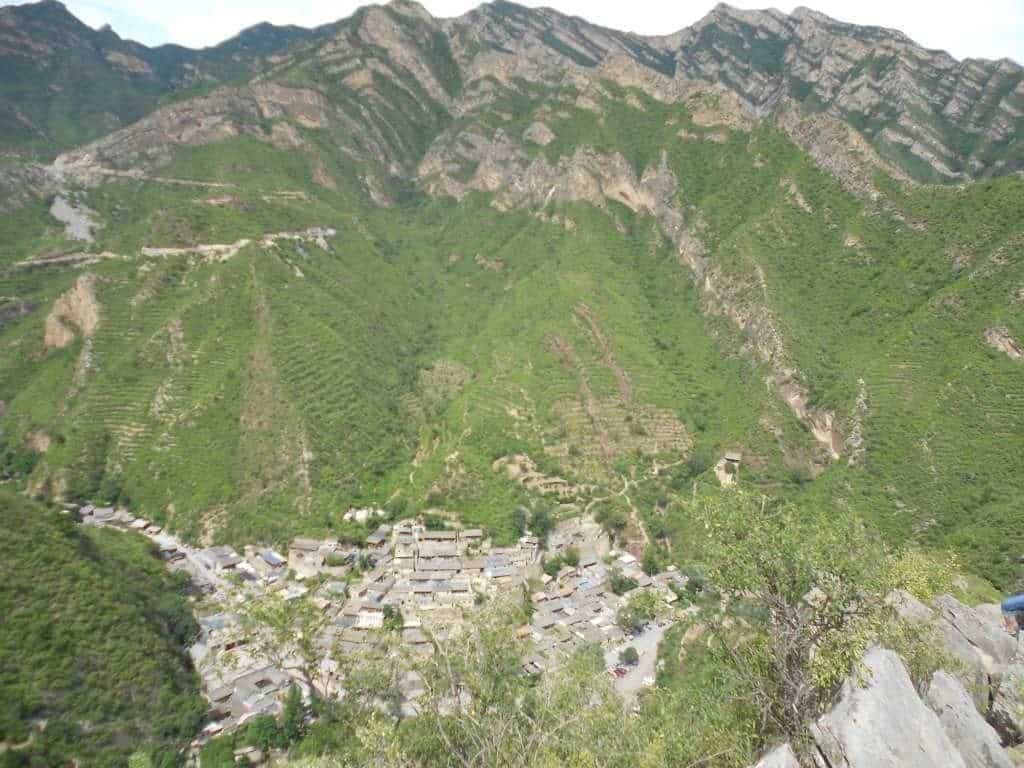
26) Visit the Great Wall of China
The Great Wall of China is possibly the ultimate Beijing sightseeing spot.
There are numerous sections of the Great Wall stretching as far as Gansu in Western China.
However, it’s important to know that these sections are not all interconnected.
It is possible to get out to the Great Wall with public transport with most of the buses going from Dongzhimen or Deshengmen bus stations.
It is possible to camp on portions of the Great Wall if you are interested in that unique experience.
Be warned, any walk on the Great Wall is no easy endeavour, so be prepared for a serious workout.
If you want to get onto the quieter and more wild sections of the wall, then check out some organized hikes that are available.
It’s certainly more expensive than taking public transport, but the routes are amazing and they will get you to some spectacular sections of the wall.
This is certainly one of the most fun things to do in Beijing.
Of all the sections around Beijing, Badaling is the one to avoid. It’s poorly restored, overcrowded and chock full of tourist tat.
Particularly great sections are Gubeikou, Mutianyu, Simatai and Jinshanling.
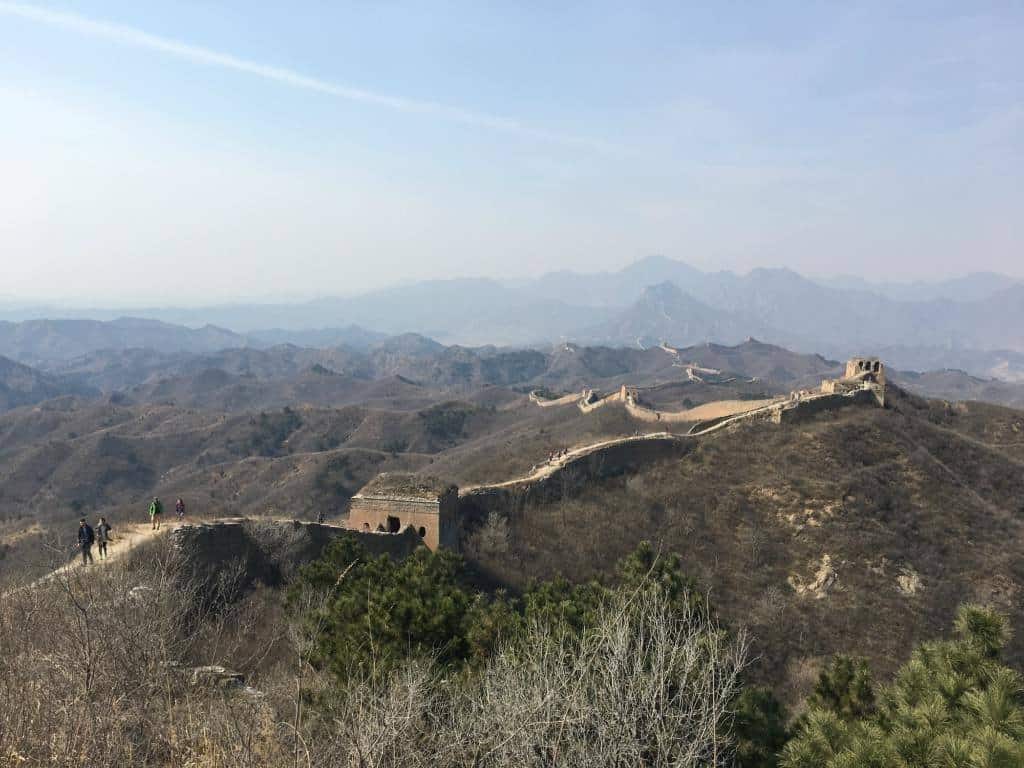
Beijing Travel Guide
Now that you know all the great Beijing activities to check out on your next visit, I want to help you plan the rest of your trip.
In this Beijing travel guide, I’ll share with you tips on how to get around, where to stay, and most importantly, where to eat!
Getting Around Beijing
English is not widely spoken in Beijing, which means that you will definitely need to make the most of translation apps and a hearty dose of sign language occasionally.
Subway
Beijing’s subway system is excellent and cheap.
The maximum you can pay for a journey is 9 Yuan, approximately USD$1.25.
The exception is if you take the airport express line with is 25 Yuan return.
You can pick up a subway card that you can pre-charge. You will need to pay a 20 Yuan deposit which is returned when you return the card.
Curiously they are not available at every station. But generally, the larger stations will have them.
To buy one simply show them this 我要买地铁卡 and then hold up your fingers to indicate how many.
The chances of finding an English speaking subway worker is slim to none. These cards also work on the buses.
Do be aware that subways end at 11:00 pm at the latest.
Buses
Beijing’s bus network is absolutely outstanding. The announcements are in English and Mandarin Chinese. However, the timetables at bus stops are usually only in Mandarin.
Download Baidu maps (the Chinese version of google maps) and you can use this to work out which buses you need to take.
Taxi
Taxi is a potentially good option. However, scams do operate and with various ride-sharing services hailing a cab can be a frustrating affair.
Also, Beijing’s rush hour traffic is a truly awful thing to be caught in so be aware.
Where to Stay in Beijing
The best place to stay is probably the Dongcheng district, which is really the heart of Beijing.
Although there would be plenty of other people that would argue differently.
Whatever you decide, the nearer you are to a subway station, the better.
Best Hostel In Beijing – Peking International Youth Hostel
The Peking International Youth Hostel is located in the heart of the Gulou area, which is home to some of the cities most pulsating hutongs.
Incidentally, there are a number of great places to eat in the area, as well as hutongs galore to explore.
This place consistently gets excellent reviews from travellers.
Being in one of the cities most central locations public transport links are excellent, but hailing a taxi in this area can be difficult.
Best Accommodation For Couples In Beijing – Ming Courtyard Hotel
This great little courtyard option is in the heart of Dongcheng making it a short walk to some of the cities best bits.
Also if you want a quintessential Chinese experience then staying in a courtyard hotel like this a must.
In addition, the area surrounding the hotel is great to explore. Like the Peking International Youth Hostel, the public transport links are excellent but hailing a taxi can be a pain.
In the mornings there are plenty of food carts nourishing Beijingers with jianbing (煎饼), a pancake with egg, lettuce, meat and some other bits, a great way to start the day.
Best Mid-range Accommodation In Beijing – The Emperor
This excellent value hotel is about 10 minutes walk from Tiananmen square and finds itself on the edge of the funky hutong area Dashilian’r, again with an almost never-ending ‘r.’
There are a number of awesome hutongs to explore in this area, a perfect evening activity.
Head south-west down towards Caishikou through Dashilian’r. This area is full of shops and restaurants.
If you’re looking for a quieter alternative head south-east towards Qiaowan subway station.
Best Luxury Accommodation In Beijing – The Orchid
This absolute gem of a hotel is hidden on Baochao hutong in the heart of the Gulou district, one of Bejing’s funkiest spots.
Check out nearby Nanluoguxiang and Beiluoguxiang, these alleyways are chock full of people and action.
If you’re looking for some real luxury it is possible to hire entire hutong homes giving you your own piece of privacy in the heart of Beijing’s hutongs.
Offering a variety of excellent spaces, top-notch food, a courtyard feel and wonderful rooftop views, this is a gem in every sense of the word.
Eating in Beijing
Chinese cuisine sometimes seems like an unending adventure of flavours, spices and styles and Beijing is the best place to sample it.
Nowhere else in China can you find such a wide range of phenomenal Chinese cuisine.
Simply put Beijing is the best place in China to sample the stunning variety of Chinese cuisine has to offer.
These restaurants are some of my favourites. But as a word of warning, do not expect much English to be spoken.
Also, food hygiene standards are not the same in China as they are in the West. However, the Chinese have a saying 苍蝇馆子 which literally translates as the best restaurants are the ones with flies.
Beijing Classics
Zha Jiang Mian (炸酱面) – This dry salty noodle dish is classic Beijing fare and you can find it all over the city.
There are a number of excellent hole in the wall noodle restaurants around the Gulou/Jiaodaokou areas of the city that serve an excellent version of this dish.
Hot Pot (火锅)
This classic Sichuan/Chongqing delicacy can also be found all over Beijing.
Check out Hiadilao (海底捞), one of the biggest restaurant chains in China or Huangmen (黄门). They can be found all over the city.
Crawfish (小龙虾)
A tray of steaming crawfish that have been cooked in some seriously spicy sauce is certainly not the tidiest thing to eat but it is simply outstanding.
Head to Tian Yi Ge (天一阁) very close to Dongzhimen subway station on the edge of ghost street.
If this isn’t your cup of tea then there is a huge menu serving other Chinese classics.
Beijing BBQ (北京烤肉)
Head to the phenomenal Long Men Xia (龙门峡) on Jiao Dao Kou East Street (交道口东大街) to sample so excellent Beijing BBQ.
Do not expect English to be spoken and the menu is written in Chinese.
However, the staff will be willing to help you to translate!
Roast Lamb Leg (烤羊腿)
Located on Andingmennei Dajie (安定门内大街) you will find the excellent Zhang Ji (张记烤羊腿).
As well as serving whole roast legs of lamb, they also have amazing chuan’r (串 skewered meat cooked over a barbecue).
Chuan’er (串)
Pronounced chwar, with what seems like an endless ‘r’ at times, you can find this all over this city.
In the summer these small restaurants spill out onto the street.
Enjoy skewered meat and vegetables washed down with a couple of beers.
Check out Stone Age (石器时代) for some excellent options.


3 thoughts on “26 AWESOME Things to Do in Beijing, China (2025 Guide)”
What a fantastic list! I can’t wait to explore the Summer Palace and dive into the local street food scene. Thank you for such detailed recommendations!
This post is fantastic! I’m especially excited about the recommendations for local street food and cultural experiences. Can’t wait to explore the hidden gems in Beijing! Thank you for such detailed suggestions!
Many thanks for this great article with things-to-do in Beijing.